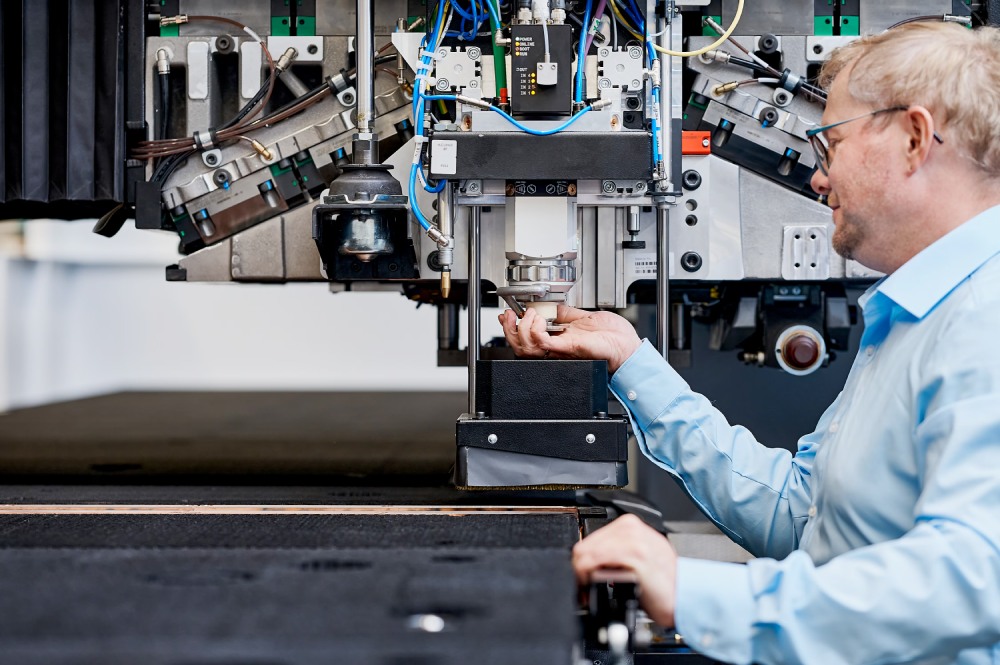TRUMPF to Introduce AI-Based ‘Runability Guide’ at INTECH 2024

Ditzingen, Germany – TRUMPF SE + Co KG is presenting the ‘Runability Guide’ at this year’s in-house INTECH exhibition, scheduled for April 9-12 at the high-tech company’s headquarters in Ditzingen. It is an initial version of a new AI-based solution that helps production employees run in the high-performance TruMatic 5000 punch laser machine more quickly and more easily.
At present, when using the machine to produce a new order with a new geometry or from new materials, users must individually test the machine program. This results in idle machine time that can quickly add up, especially with fully automated machines that produce many different parts. With TRUMPF’s AI-supported software Runability Guide, users can avoid idle times of up to 20 minutes when running in the system. Based on various evaluation models, the new run-in assistant shows for each new job whether the TruMatic 5000 can produce parts directly or whether manual intervention will be required.
“Our Runability Guide gives companies an advantage in productivity and competitiveness,” explains Jonathan Eberle, Project Leader, Development, TRUMPF. “This not only saves them time but also means they can then use employees’ skills for other value-creating tasks or for training new personnel.”
Software recommends which parts are suitable for night-shift production
When a machine produces parts automatically, problems can occur. For example, an automated machine may be unable to remove the part cleanly from the scrap skeleton. The result is machine downtime until a production employee has manually removed the part from the machine interior and restarted the process. Whether the part can be removed without interrupting the process depends, among other things, on its geometry and how the grippers are positioned on the workpiece.
In this case, TRUMPF’s Runability Guide will check, for example, how much the part will buckle as a result of gravitational force during removal and thereby possibly cause the process to jam. If a predefined limit value is exceeded, the software marks the corresponding area in red. This means that users can see immediately which parts of a job require attention. In addition to analyzing possible problems, the software also recommends which jobs are suitable for the night shift.
“Normally, an expert would have to assess the geometry of the part along with the material, sheet thickness, and other factors,” Eberle says. “But our solution uses AI to make this decision and also learns on the job for future problems.”

Evaluation in a matter of seconds
TRUMPF’s Runability Guide uses various models to determine a part’s complexity. For this purpose, development engineers from TRUMPF continually upload knowledge from production experts into the cloud. In addition, the software uses physical simulations and AI in order to identify any possible problems in each of the process steps. Last but not least, the solution also works with genuine machine data from TruMatic 5000 users. This enables it to draw inferences about potential issues during processing.
“Once all the models have been used to evaluate the job, the solution delivers its assessment,” Eberle explains. “Depending on the part, this would take up to an hour with classic physical simulation models. But by using AI, we can significantly accelerate this process, meaning that our customers can use it virtually in real time.”
Machine data from users required to further improve the software
For companies purchasing the TruMatic 5000 from TRUMPF, the Runability Guide is included in the scope of delivery – provided they make their machine data available to TRUMPF. “Unlike conventional software, users start with only a small scope of functions,” Eberle concludes. “Their production data then helps us to continually improve the solution, which in turn benefits our customers. This is the kind of new development approach we need in order to generate value from the use of data and AI in production.”
Image Source: TRUMPF




 Facebook
Facebook.png) Twitter
Twitter Linkedin
Linkedin Subscribe
Subscribe